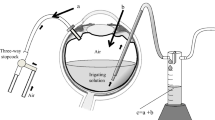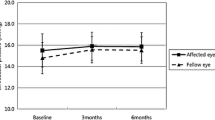Abstract
Purpose
To develop an equation for estimating the vitreous chamber volume in pseudophakic patients based on the axial length of the eye.
Methods
A consecutive series of patients who underwent vitrectomy surgery for a macular hole or an epiretinal membrane were enrolled. The inclusion criteria were as follows: having pseudophakia, being older than 50 years, and having eyes with axial length ranging from 21 to 26 mm. Before the surgery, the axial length was measured using optical biometry. Pars plan vitrectomy was performed, and, after the fluid-air exchange, the vitreous chamber was filled with Brilliant Blue G (0.005%). The infused volume of each eye was recorded. Then, epiretinal membrane peeling or internal limiting membrane peeling and a new fluid-air exchange were performed. Main outcomes and measures were the vitreous chamber volume and axial length.
Results
The sample consisted of 112 patients. The mean [standard deviation (SD), range] age was 71 years (7, 53–90). Sixty-five individuals (58%) were women. In 58 (51.8%) patients, surgery was performed on the right eye. The mean (SD; range) axial length was 23.78 mm (0.93; 21.55–25.26), and the mean (SD; range) vitreous chamber volume was 4.96 mL (0.69; 3.60—6.40). Pearson’s correlation coefficient (r = 0.950; p < 0.01) was positive, and the coefficient of determination (R2) was 0.902. The estimated regression equation was Y = 0.71X − 11.84, where Y was the vitreous chamber volume, X was the axial length of the eye, the linear coefficient for the straight line was − 11.83, and the angular coefficient was 0.71 (p < 0.01).
Conclusion
These data suggest that the vitreous chamber volume is significantly correlated with the axial length and the former could probably be calculated using biometry. New studies with larger samples will be required to confirm these observations and will allow the development of an algorithm (perhaps non-linear) that includes extreme axial length values and that takes into account other factors such as the status of the lens and sex.



Similar content being viewed by others
Data availability
We had full access to the data and take responsibility for the scientific accuracy of the research findings, data integrity, and research methods used.
References
Lee B, Litt M, Buchsbaum G (1992) Rheology of the vitreous body. Part I: viscoelasticity of human vitreous. Biorheology 29:521–533
Sebag J, Balazs EA (1989) Morphology and ultrastructure of human vitreous fibers. Invest Ophthalmol Vis Sci 30:1867–1871
Kleinberg TT, Tzekov RT, Stein L, Ravi N, Kaushal S (2011) Vitreous substitutes: a comprehensive review. Surv Ophthalmol 56:300–323
Jashnani KD, Kale SA, Rupani AB (2010) Vitreous humor: biochemical constituents in estimation of postmortem interval. J Forensic Sci 55:1523–1527
Kaplan HJ, Chiang C-W, Chen J, Song S-K (2010) Vitreous volume of the mouse measured by quantitative high-resolution MRI. Invest Ophthalmol Vis Sci 51:4414–4414
Xu HM, Zhou YX, Shi MG (2008) Exploration of three-dimensional biometric measurement of emmetropic adult eye-ball by using magnetic resonance imaging technology. Zhonghua Yan Ke Za Zhi Chin J Ophthalmol 44:1007–1010
Azhdam AM, Goldberg RA, Ugradar S (2020) In vivo measurement of the human vitreous chamber volume using computed tomography imaging of 100 eyes. Transl Vis Sci Technol 9:2–2
Tanaka H, Nitoh K, Atsuhiro A, Shimada Y, Kuze M, Nakamura A et al (2009) Measurement of volume of vitreous space during vitrectomy. Invest Ophthalmol Vis Sci 50:3169–3169
Fontes BM, Fontes BM, Castro E (2011) Intraocular lens power calculation by measuring axial length with partial optical coherence and ultrasonic biometry. Arq Bras Oftalmol 74:166–170
Tanaka H, Tanikawa A, Shimada Y, Miyake Y, Mizuguchi T, Horiguchi M (2020) Measurement of the volume of the vitrectomized space during vitrectomy in myopic patients with retinal detachment. Jpn J Ophthalmol 64:210–215
Fotedar R, Wang JJ, Burlutsky G, Morgan IG, Rose K, Wong TY, Mitchel P (2010) Distribution of axial length and ocular biometry measured using partial coherence laser interferometry (IOL master) in an older white population. Ophthalmology 117:417–423
Lira RPC, Arieta CEL, Passos THM, Maziero D, Astur GL d V, do Espírito Santo ÍF et al (2017) Distribution of ocular component measures and refraction in Brazilian school children. Ophthalmic Epidemiol 24:29–35
Bikbov MM, Kazakbaeva GM, Gilmanshin TR, Zainullin RM, Arslangareeva II, Salavatova VF et al (2019) Axial length and its associations in a Russian population: the ural eye and medical study. PLoS One 14:e0211186
Grosvenor T (1987) Reduction in axial length with age: an emmetropizing mechanism for the adult eye? Optom Vis Sci 64:657–663
Kazajkin ВН, Ponomarev ВО (2019) Study of the effectiveness of precision doses of antibiotics in the treatment of induced acute bacterial postoperative endophthalmitis in an experiment. Ophthalmologe Russ 16:522–528
Waiswol M, Cursino JW, Cohen R (2001) Variation of human lens dimensions according to age. Arq Bras Oftalmol 64:507–512
Author information
Authors and Affiliations
Corresponding author
Ethics declarations
Conflict of interest
The authors declare that they have no conflict of interest.
Ethics approval
This study was approved by the Research Ethics Committee (CAAE no. 26684819.4.0000.8807) of Hospital das Clínicas at Universidade Federal de Pernambuco (HC-UFPE).
Consent to participate
All the patients signed an informed consent form regarding the risks and benefits of the surgical procedure to which they were submitted.
Consent for publication
In consideration that Graefe’s Archive for Clinical and Experimental Ophthalmology is taking action in reviewing and editing our submission, which represents an original article, the authors hereby transfer, assign, or otherwise convey all copyright ownership to the Springer, in the event that this work is published in the journal Graefe’s Archive. The manuscript is not being considered for publication elsewhere, and there are no other manuscripts being submitted from this same study.
Code availability
Not applicable.
Additional information
Publisher’s note
Springer Nature remains neutral with regard to jurisdictional claims in published maps and institutional affiliations.
Institution where the work was done: Universidade Federal de Pernambuco, Recife, Brazil
Rights and permissions
About this article
Cite this article
de Santana, J.M., Cordeiro, G.G., Soares, D.T.C. et al. Use of axial length to estimate the vitreous chamber volume in pseudophakic. Graefes Arch Clin Exp Ophthalmol 259, 1471–1475 (2021). https://doi.org/10.1007/s00417-020-04991-3
Received:
Revised:
Accepted:
Published:
Issue Date:
DOI: https://doi.org/10.1007/s00417-020-04991-3




